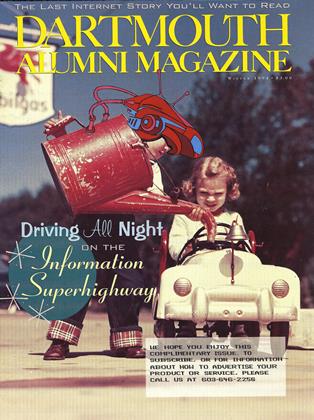Engineering Professor Albert Henning ’77: Why do you Bake Brownies to Demonstrate Chaos Theory?
Winter 1993Engineering Professor Albert Henning ’77: Why do you Bake Brownies to Demonstrate Chaos Theory? Winter 1993
Engs22, Systems, is, like most of the core classes in the engineering sciences major, a general class, with a strong mathematical foundation. In this course I use the math of ordinary differential equations to study just about any type of dynamic (or time-depen- dent) system I can think of. I’ve used figure skaters as examples; the “Death Slide” ice run that Theta Delt builds each winter (we do a real experiment carried out by several stu- dents, using a radar gun donated by the baseball coach to measure tobog- gan speed); electrical cir- cuits; mechanical systems; thermal systems (“what’s the temperature of the earth ifwe assume...”); chemical systems; biologi- cal systems.
All these systems, how- ever, are either linear, with highly predictable re- sponses, or non-linear, which can be linearized mathematically and then studied with the techniques of linear mathematics.
We also need a little chaos.
Keying off of James Gleick’s book Chaos, I spent some time trying to decide what to include in a lecture devoted entirely to chaotic systems. I was bak- ing brownies at home one night and telling my wife, Carol Muller ’77 (then as- sistant dean of engineer- ing), about chaotic-system behavior. For example, there is a particular type of plot, named after the French mathematician Poincare, that can be used to show how chaotic sys- tems develop. Plotting them on a computer re- veals an amazing and beau- tiful structure, far from the chaos one would see ob- serving the behavior of the system in real time.
While I spoke to my wife, I noticed that the recipe I was using called for butter to be melted with unsweetened baker’s chocolate. The mixture it- self is quite, well, chaotic. Once other butter, flour, sugar, and eggs are folded in and beaten together, the chocolate-butter mixture is poured into the slowly turning mixing bowl. As I tipped the mixture in, I said, “Hey, this looks just like that Poincare plot!” To which Carol replied, “Why don’t you show it to your class?”
This proved a great idea. First, it shows a chaotic sys- tem, in real time. Second, it shows a man cooking—and some of us still think we could use more men in such role models. Third, we rush the mixture, appropriately spatulaed into a pre-but- tered baking pan, off to the ovens at Tuck—in time for a warm treat right as class ends.
Ah, order out of chaos.
 View Full Issue
View Full Issue
More From This Issue
-
 Cover Story
Cover StoryProcrastinator’s Night Confessions of a Collegiate Insomniac
Winter 1993 By Jane Hodges ’92 -
 Feature
FeatureBIG JUMP
Winter 1993 By David Bradley ’38 -
 Feature
FeatureAn Environmental B
Winter 1993 By Noel Perrin -
 Feature
FeatureMoriarty Ad Lib
Winter 1993 By Robert Sullivan ’75 -
 Article
ArticleDivers Notes & Observations
Winter 1993 By “E. Wheelock” -
 Article
ArticleThe City Peter Built
Winter 1993 By Karen Endicott







